How Not To Do Yoga
This blog post explains how some common yoga injuries occur and how applying the principles of healthy posture to yoga postures replaces this scenario with movements that are good for your body.
Yoga postures and back pain
Growing up in Mumbai, India, my Dutch mother was a student of BKS Iyengar and the Satyananda yogis, and keen for me also to learn yoga asanas, or postures. I practiced, and, being reasonably athletic as a child and already trained in Indian classical dance (Bharata Natyam), did not find it particularly difficult to choreograph the back bends, forward bends, and twists that were asked of me. I became a yoga model, demonstrating postures alongside visiting swamis’ presentations to induce the audience to sign up for upcoming yoga courses.

This photograph shows me teaching yoga as best as I knew how in 1979, standing with a sway in my back (and putting excess flexion into my student's neck).
Aged 15, I came to the United States as an exchange student and proceeded to go to college here. It was while doing a yoga pose in college that I first experienced a significant back episode with severe spasms. A few years later I injured my back while windsurfing; this time it took five days of bed rest to recover. I did weight training to strengthen my back, and returned to normal activity.
When nine months pregnant with my first child, my back problem resurfaced with an onset of sciatica. After my baby’s birth, it grew worse, leading to surgery for a large disc herniation at L5-S1 a year later. Within another year the pain had returned. I declined a second surgery, and instead deepened my quest to understand the causes of back pain and how best to resolve it.

An MRI scan done in 1987 revealed the cause of my sciatica and severe back pain—a large herniation at L5-S1.
Yoga postures require healthy posture
I learned from my life experience, as well as that of key teachers such as Noelle Perez, that in the industrialized world we do not use our bodies well. As our posture has deteriorated, traditional ways of performing everyday tasks in sitting, standing, and bending positions have become distorted. These damaging postural patterns are now deeply embedded in our culture and have even been unwittingly carried through into therapeutic activities such as yoga.
How is it that yoga asanas, developed to bring strength, flexibility, and relaxation to the body, are now causing frequent injury? This question has been the subject of much media coverage in recent decades, including the provocative New York Times article in 2012, How Yoga Can Wreck Your Body¹. From a Gokhale Method® perspective, the primary problem is that poor posture in the population at large, including yoga students, combined with misguided conventional wisdom shared by yoga teachers about what constitutes good posture, has created a perfect storm.
I came to realize that much of the flexibility I had as a young yoga model came from the wrong places—it was achieved at the expense of my lumbar discs and nerves as I compressed them to sway back, round forward, and twist. Let’s take a look at how yogis are likely to be causing themselves injuries and how using the Gokhale Method to apply the principles of healthy posture will avoid them:
Back bends
A large group of yoga postures are backbends. Bending backwards is something that is generally done extremely poorly in our culture, with most of the bend occuring around waist level. This puts a great deal of pressure on discs, nerves, and soft tissue in an area of the lumbar spine already compressed by tight erector spinae (long back muscles). This shortened baseline length is due to poor posture and furniture, part of our culture’s paradigm shift away from a healthy spine shape. You can read more about spine shape in my blog post What Shape is Your Spine?
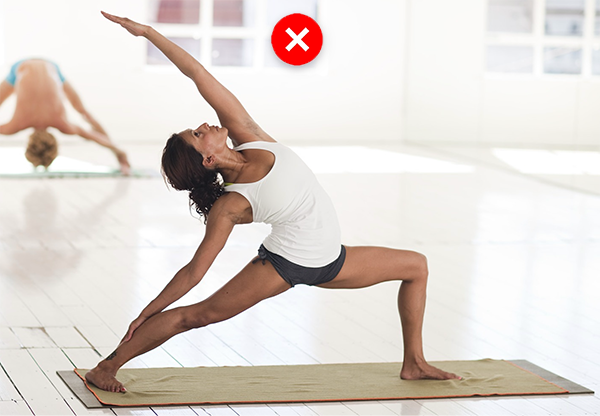
Many versions of Warrior pose, or Virabhadrasana in Sanskrit, are taught with a significant bend in the upper lumbar spine or thoraco-lumbar junction. This is especially a problem when one or both arms are lifted, encouraging the ribs to pop up. Pixabay
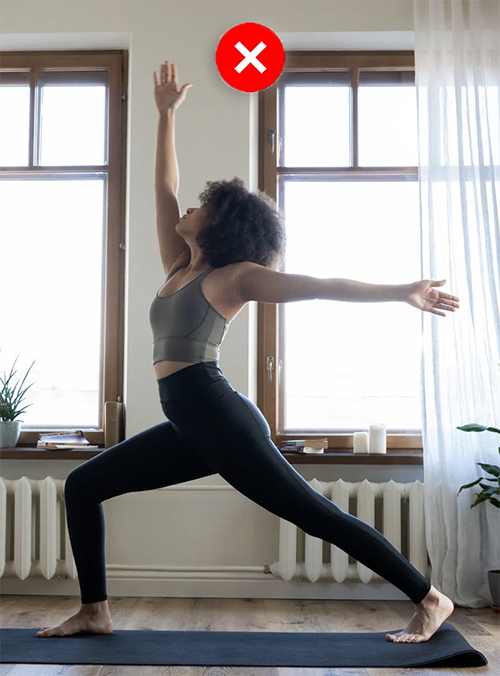
Even mild sways perpetuate tight muscles in the lumbar area and correspond with a lack of healthy articulation at L5-S1, the lumbosacral junction. Pexels
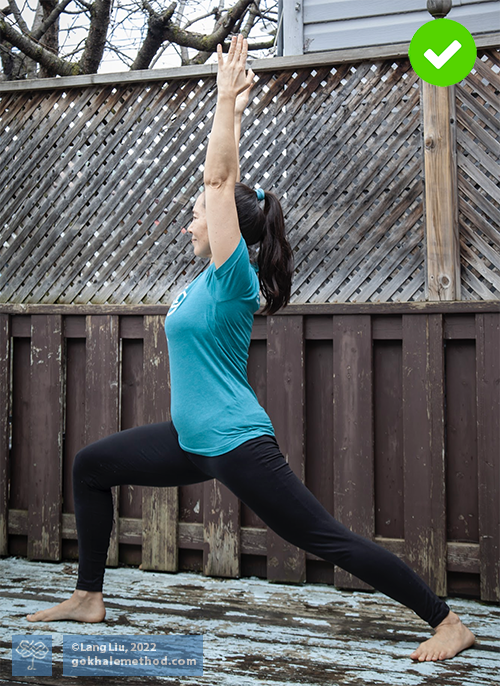
Gokhale Method teacher Lang Liu shows how anchoring your rib cage prevents swaying and encourages healthy articulation at L5-S1. You can read more about our approach to this pose in my blog post Why Keep the Body forward in Warrior I
Forward bends
Many yoga postures contain some form of forward bend. This can be standing, sitting, symmetrical or asymmetrical, with the legs together or wide apart. Regardless of these permutations, from a Gokhale Method perspective, the key point is to make bending healthy and avoid the damage that comes with rounding the back, distending the spinal ligaments, and pinching the front of the discs.

Standing forward bends (Uttanasana) are often taught with legs straight. This leaves most students in our culture, who have tight hamstrings, straining towards the ground with their shoulders pulled forward. It also rounds the back, distending the spinal ligaments and pinching the front of the discs. Hanging off the lower back is also aggravating for the sacro-iliac joints and soft tissue in the area. Pexels
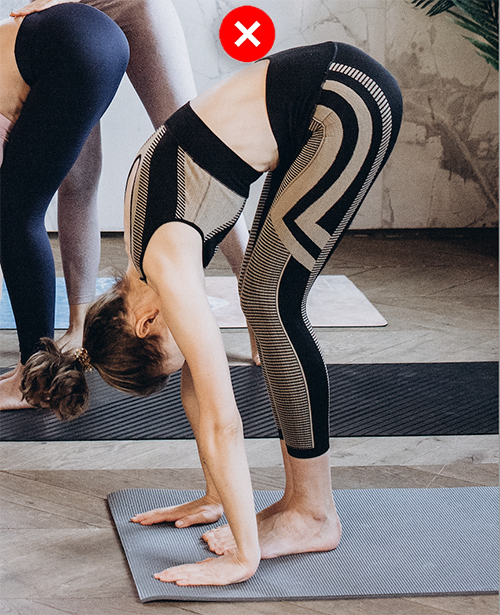
Bending the knees softens tight hamstrings allowing a lower bend to the floor—but this student is still rounding her torso to reach over her pelvis and legs to reach the floor. Pexels
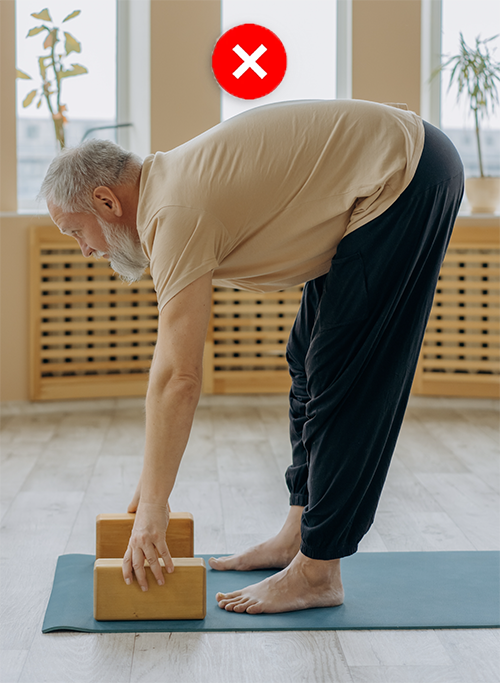
This man is using blocks to reach the floor. He is still rounding his back, and severely compressing his neck to try and look ahead. Pexels
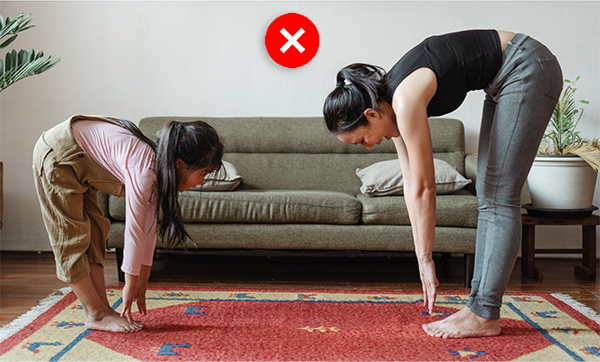
Unfortunately this well-meaning mother is teaching her daughter poor bending form. This is especially regrettable as young children naturally tend to bend healthily by hip-hinging. Pexels
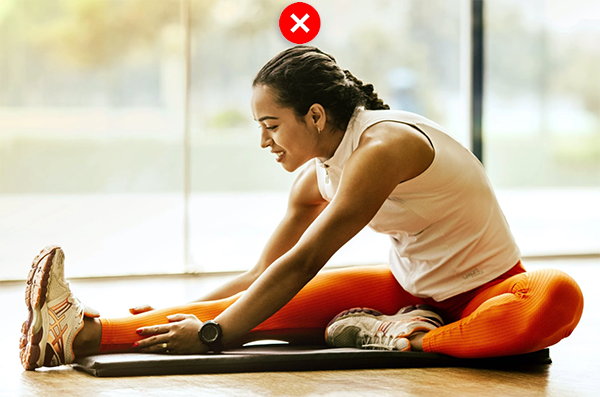
In seated forward bends yoga students often hunch forward. This compounds any rounding already established in the upper back, and forward rounding of the shoulders. Her head also strains forward, chin up, compressing the back of the neck. Pexels
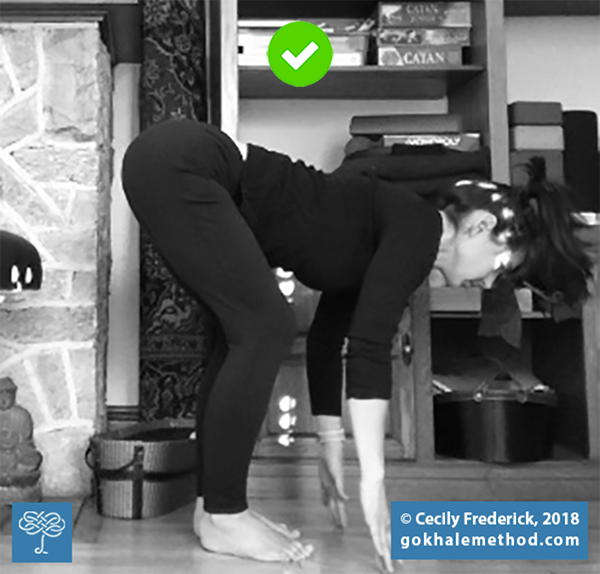
Gokhale Method teacher Cecily Frederick hip-hinges in a standing forward bend. Her pelvis rotates forward around the femoral heads (tops of the thigh bones that form part of the hip joints). Her spine remains long, rather than rounding.
Twists
In twisting postures (Parivrtti), it is especially important that your movement is not concentrated at a particular level of the spine, but is well distributed. Levering into a twist by pushing or pulling with the arms or legs can cause a twist to concentrate at any vulnerable point. Typically people will twist most in the mid-spine at T12-L1. Here the more axially mobile thoracic spine meets the lumbar area, where the orientation of the facet joints limit rotation. This is likely to result in disc bulging or even herniation at this junction, pinching of the nerves, and undue stress on the bony spine.
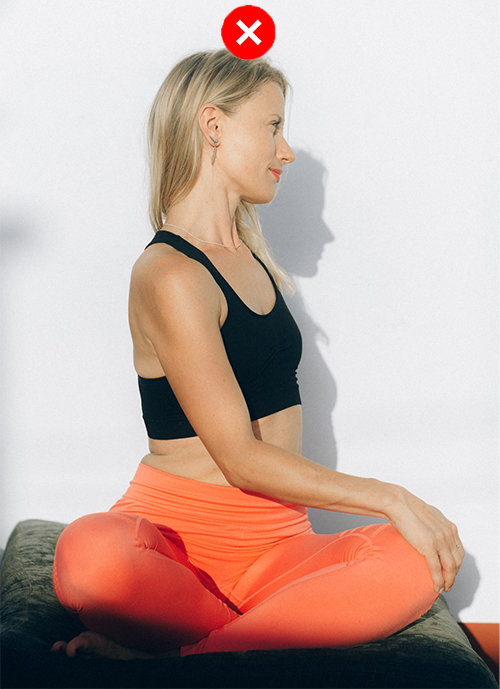
This woman is twisting mostly at the waist. Pexels
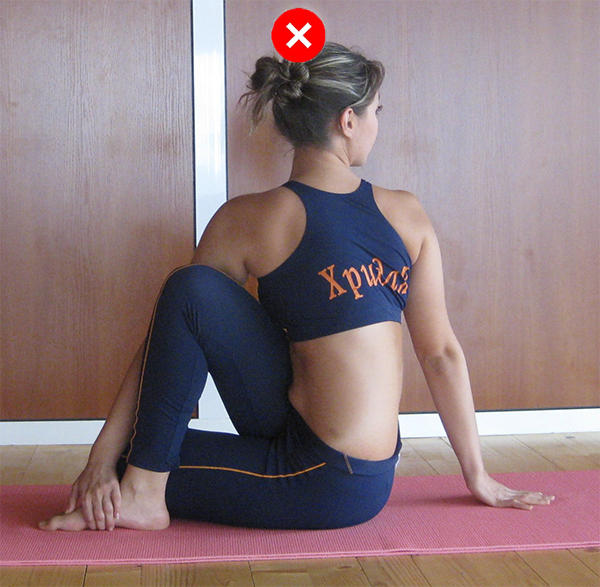
This seated twist shows tucking of the pelvis. There is considerable rotation at the base of the shoulder blades as the yogini levers with her arms against a fixed pelvis and legs. Wikimedia
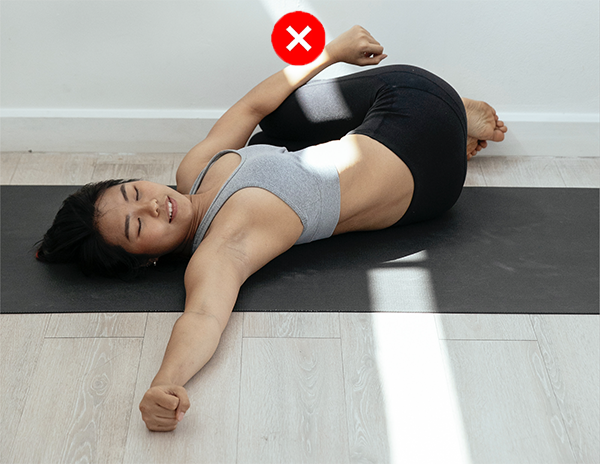
A lying twist with one knee reaching the floor and the opposite shoulder remaining there is an extreme rotation for most people. It will often compromise healthy posture. In this case the woman is using her forearm and tucking her pelvis slightly to get her knees down. It is better to prioritize healthy movement over achieving the “correct” shape. Pexels
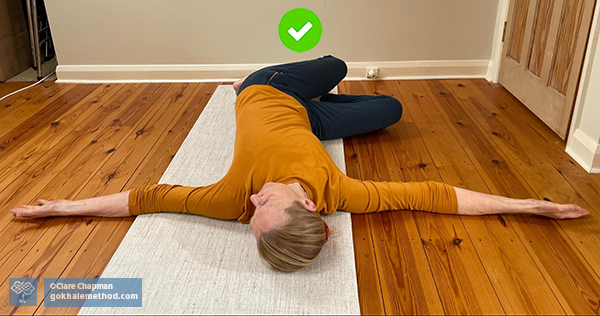
Gokhale Method teacher Clare Chapman in a lying twist. Allowing the pelvis to rest back and the thighs to separate avoids tucking and encourages more rotation in the hips.
We recommend that you initiate twists using the muscles of the torso’s inner corset, especially the obliques. The inner corset is explained in detail in Lesson 5 of my book 8 Steps to a Pain-Free Back. Using these muscles means that the lumbar spine is protected while the muscles originating in the thoracic area and connecting to the pelvis power the rotation. Engaging the inner corset also lengthens the spine avoiding the common pitfall of imposing rotation on top of flexion (rounding) or extension (swaying) or any other kind of compression.
Twists should mainly occur and be appropriately distributed in the joints best designed for them—the ankles (standing twists), hips, the thoracic spine, and the neck. Small amounts of rotation can contribute from elsewhere, but pushing beyond natural limits anywhere by applying force is a recipe for injury and pain.
Before executing yoga bends or twists, we recommend that you first learn the basics of the Gokhale Method® in our in-person Foundations Course, Pop-Up courses, or online Elements. These courses teach you how to bend back without swaying, and how to bend forward in a way that profoundly benefits rather than damages your body. The Gokhale Method Online University has many offerings for Alumni which explore additional movements such as shearing and twisting in ways that are healthy.
If you are a yoga practitioner who suffers from recurrent bouts of back pain or strain, have stopped practicing due to injury, or have been put off even trying yoga, then a solution is at hand!
It has long been my ambition to offer yoga classes with healthy posture. I am delighted that one of our most experienced and accomplished teachers, Lang Liu, will offer regular Tuesday and Thursday Gokhale Yoga classes, 7:00 am (Pacific Time), starting April 21, as part of our Alumni Gokhale Exercise program.
We look forward to seeing you there.
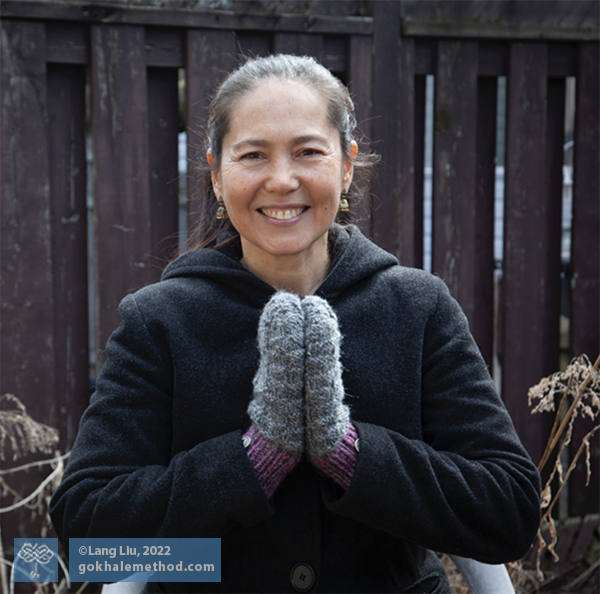
Gokhale Method teacher Lang Liu looks forward to seeing you in the Gokhale Yoga class.
References:
¹ William Broad, “How Yoga Can Wreck Your Body”, New York Times Magazine, Jan. 5, 2012,
https://www.nytimes.com/2012/01/08/magazine/how-yoga-can-wreck-your-body.html
If you would like to find out more about how the Gokhale Method can help support you, sign up to join one of our upcoming FREE Online Workshops…

Comments
Thank you for showing us what
Thank you for showing us what not to do...I look forward to seeing yoga a la Gokhale Method...seems perfect for the Posture Tracker...
This is an exciting
This is an exciting development. I look forward to attending the class.
Very interesting article.
Very interesting article. Kladionice 101 are international brand for Balkan countries focused on online bookmaker reviews, bonuses promotions and everything related to sports betting and strategies.
vavada-srbija je zvanicni
vavada-srbija je zvanicni sajt online kazina Vavada, gde mozete preuzeti svoj bonus dobrodoslice.
Analisi molto professionale e
Analisi molto professionale e approfondita di questa antica disciplina. Fare yoga è molto più complicato di quanto si possa leggere nei giornali di lifestyle o sentire da lifecoach e altri guru di youtube. Lei è andato dritto al punto. Puoi parlarci delle pratiche https://mostbet-it.it/ che sono popolari soprattutto in Italia?
Add New Comment
Login to add commment
Login